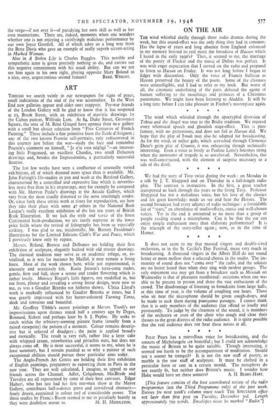ART
THOUGH we search vainly in our newspapers for signs of peace, small indications of the end of the war accumulate. In the West End new galleries appear and older ones reappear. Pre-war friends of the London Gallery will be glad to know that it has reopened at 23, Brook Street, with an exhibition of atavistic drawings by the Cuban painter, Wilfredo Lam. At 84, Duke Sweet, Grosvenor Square, the sons of M. Rene Gimpel have opened their ne,v gallery with a small but choice selection from " Five Centuries of French Painting." These include a fine primitive from the Ecole d'Avignon ; one of the two known Poussin self-portraits, only rediscovered in this country just before the war—study the face and remember Poussin's comment on himself, " Je n'ai nen neglige "—an interest- ing little Fragonard, an excellent Chardin, two small Delacroix drawings and, besides the Impressionists, a particularly successful Soutine.
The last few weeks have seen a confluence of unusually varied exhibitions, all of which demand more space than is available. Mr. John Farleigh's life-studies in pen and wash at the Batsford Gallery, characterised by a controlled and expressive line which is neverthe- less more free than in his engravings, may for example be compared with Mr. Mervyn Peake's drawings at the Arcade Gallery, which vary from the most cruelly distorted to the most touchingly tender. Or, since both these artists work at times for reproduction, see how they take their place with some 47 others in the National Book League's really excellent exhibition of the last ten years of British Book Illustration. If we lack the style and verve of the finest Continental book-production, we are surely supreme in the lower price fields where the revival of lithography has been so especially striking. I was glad to see, incidentally, Mr. Barnett Freedman's illustrations for the Limited Editions Club's War and Peace, which I previously knew only by repute.
Messrs. Roland, Browse and Delbanco are holding their first exhibition of sculpture, elegantly backed with old master drawings. The classical tradition may serve as an academic refuge, or, re- vitalised, as it was for instance by Maillol, it may remain a living force. Most of the work shown here, while not experimental, is sincerely and sensitively felt. Karin Jonzen's terra-cotta nudes, gentle, firm and full, show a serene and tender flowering which is rather lovely. Moissey Kogan's little figures, not modelled in, but cut from, plaster and revealing a strong linear design, were new to me, as was a Gaudier Brzeska not hitherto shown. Ulrica Lloyd's work is markedly influenced by Gaudier Brzeska at times, but I was greatly impressed with her butter-coloured Turning Torso, sleek and sensuous and beautiful.
Mr. Geoffrey Tibble's recent paintings at Messrs. Tooth's are improvisations upon themes stated half a century ago by Degas, Bonnard, Sickert and perhaps later by S. J. Peploe. He seeks to catch within the arbitrary-seeming picture frame (usually from a raised viewpoint) the pattern of a moment. Colour remains descrip- tive but is relieved of drudgery ; the paint is applied broadly and exotically. The result is very rich, rather like a layer cake with whipped cream, strawberries and pistachio nuts, but does not always come off. He is most successful, it seems to me, when he is least summary, but I remain puzzled as to why a painter of such exceptional abilities should pursue these particular aims today.
The Anglo-French Art Centre are holding their first exhibition of English paintings, preparatory to exporting them to Paris in the new year. They are well calculated, I imagine, to appeal to our friends across the Channel. Adler, Colquhoun, MacBryde and Trevelyn are all represented by some of their best canvases. Edgar Hubert, who has just had his first one-man show at the Mayor Gallery, contributes half-a-dozen grave and considered abstracts— freely drawn, restrained in colour and of considerable power. The three studies by Francis Bacon seemed to me as peculiarly beastly as


































 Previous page
Previous page